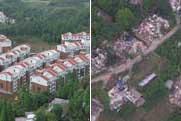China
Full text: China´s Actions for Disaster Prevention and Reduction
IV. Enhancement of Disaster-reduction Capability
The Chinese government attaches great importance to the enhancement of disaster-reduction capability. It has made great efforts in undertaking disaster-reduction projects, improving disaster early warning and emergency response, enhancing sci-tech support, strengthening personnel training and disaster reduction work in communities.
1. Carrying out Disaster-reduction Projects and Improving Capability in Comprehensive Prevention of Disasters
In recent years, China has engaged in a series of important disaster-reduction projects, including those concerning flood control, drought combat, earthquake prevention and relief, cyclone control, red tide and other marine disaster prevention, desertification and sandstorm control, and ecological construction.
-- Flood control on major rivers. The government has greatly in-creased its input in harnessing major rivers by way of adopting proactive financial policies and issuance of bonds, which has accelerated the progress of the harnessing of major rivers and lakes. To date, the construction and renovation of the dykes on the middle and lower reaches of the Yangtze River have been completed; construction of standardized dykes on the lower reaches of the Yellow River is in full swing; 19 major flood control projects for the Huaihe River have been, by and large, completed; and pivotal water conservancy projects at the Three Gorges on the Yangtze River, Xiaolangdi on the Yellow River and Linhuaigang on the Huaihe River are playing their full part. China's flood control ability on major rivers has been further improved. Construction work on some major sections of these rivers is now capable of defying the severest flood in 100 years. The flood control capability of small and medium-sized rivers has been continuously improved. The standard for key sea dykes has been raised to withstand the worst flood in 50 years.
-- Housing renovation for impoverished rural residents. China attaches great importance to disaster-proof residential construction in rural areas. During the reconstruction of disaster-stricken buildings, technical guidance is given and quality control stressed on site selection, design, construction and acceptance inspection. Housing projects are pushed forward in combination with poverty alleviation efforts. Since 2005, a total of 17.535 billion yuan has been invested nationwide in the renovation and construction of 5.8016 million rural houses for 1.8051 million impoverished households totaling 6.4965 million people.
-- Decrepit school building renovation. Since 2001, a school building renovation scheme has been implemented throughout the country. By the end of 2005, a special fund of 9 billion yuan from the state revenues has been allocated for renovating the decrepit buildings of over 40,000 schools. Since 2006, building renovation expenses of all primary and junior high schools in rural areas have been included in the financial support scheme for compulsory education in rural areas.
-- Safe school buildings. Starting from 2009, the state will reinforce school buildings nationwide in order to make them meet the earthquake withstanding standard applied for key projects within three years. They should also meet the requirements in preventing and avoiding disasters caused by mountainside landslide, rock collapse, mud-rock flow, tropical heat wave, fire, etc.
-- Seepage prevention and reinforcement for unsafe reservoirs. In March 2008, the state issued the Special National Plan on Seepage Prevention and Reinforcement for Unsafe Reservoirs, requiring the completion of renovation of large and medium reservoirs as well as key small-sized ones threatened by floods within three years. In 2008, 4,035 seepage prevention and reservoir reinforcement projects were undertaken, accounting for 65 percent of the total 6,240 targeted reservoirs.
-- Drinking water safety in rural areas. During the Tenth Five-year Plan period (2000-2005), a total of 22.3 billion yuan was spent on solving the problem of drinking water for 67 million people in rural areas, thus basically ending the history of a serious shortage of drinking water in rural areas. Since 2006 priorities have been shifted to guaranteeing that all drinking water is safe. From 2006 to 2008, 23.8 billion yuan were invested by the state revenues and 22.6 billion yuan invested by local revenues for providing safe drinking water to an accumulated rural population of 109 million.
-- Water and soil erosion control. In the 1980s, key water and soil erosion control projects were launched in areas suffering from serious water and soil erosion, such as those along the Yellow and the Yangtze rivers. During the later period of the Ninth Five-year Plan (1996-2000), efforts were extended to the upper and middle reaches of the seven major rivers (Yangtze, Yellow, Huaihe, Haihe, Songhua, Liaohe, Pearl) and the Taihu Lake. By 2008, key water and soil erosion control projects had covered a total area of 260,000 sq km, with 70 percent of such areas put under control and a silt reduction rate of 40% or more. Soil erosion in the Jialing River area, on the upper reaches of the Yangtze River, has been reduced by one third, while the sediment flow into the Yellow River has been reduced by about 300 million tons per annum.
-- Farmland irrigation and drainage. Since the beginning of the Ninth Five-year Plan, China has increased financial input in farmland irrigation and drainage facility construction, focusing on construction of support facilities and water-saving facilities in major irrigation areas.
As a result, farmland irrigation and drainage as well as flood and drought resistance abilities have been improved.
-- Ecological construction and environmental improvement. Since the beginning of the 21st century, key ecological construction projects have been carried out, including those concerning natural forest resources protection, reverting farmland to forest, shelter forest construction in the northeast, north and northwest of China, key shelter forest construction on the lower reaches of the Yangtze River, sand-storm sources control in the Beijing and Tianjin areas, desertification control in karst landform areas, wildlife protection and nature reserve construction, coastal shelter forest construction and the restoration of pasturage to natural grassland. All these projects are aimed at checking the rapid expansion of desertification and reduce the damages caused by extreme climatic conditions. Pilot ecological compensation work has been carried out and experimented with six ecological compensation projects, including rational coal resources development in Shanxi Province. Efforts have also been made in the field of ecological construction at the provincial, municipal and county levels, and in building ecological towns and villages with excellent surroundings, especially pushing ahead the construction of 103 key demonstration counties.
-- Construction of earthquake-proof buildings and facilities. China has promulgated the Regulations on the Administration of Disaster Prevention of Urban Public Utilities, the Urban Earthquake and Disaster Prevention Planning Standards and the Design Specifications for Earthquake-proof Buildings in Towns (Townships) and Villages. China has published the Zoning Map of China with Seismological Parameters, improved its earthquake-proof evaluation management system for key construction projects, and promoted the implementation of safety guarantees for earthquake-proof houses in rural areas. Construction and reinforcement of 2.45 million such houses have been completed. After the 2008 Wenchuan earthquake in Sichuan Province, the Earth-quake-proof Classification Standards for Construction Projects and the Earthquake-proof Construction Design Specifications have been revised.
-- Highway disaster prevention. Since 2006, in view of highways being destroyed by flood or earthquake, the state has implemented highway disaster prevention projects. By 2008, a total of 1.54 billion yuan had been invested to renovate road embankments, roadbeds, bridge structures and flood-proof and drainage facilities with focus on disaster prevention facilities in mountainous and hilly areas. The disaster-prevention capability of China’s ordinary highways has also been improved in an all-round way.



